When Bruno Labbadia took over in Wolfsburg in February 2018, his new team was only one point above the relegation play-off zone.
While they hardly managed to stay in the league, the 54-year-old significantly improved his side in the next season.
Although not quite as bad, the situation in Berlin is in many ways similar.
An ambitious club that once again struggled to live up to the expectations, currently fighting against relegation.
In previous years, Hertha have established themselves as a solid team in the midfield of the Bundesliga.
However, after 4.5 relatively successful years under Pál Dárdai, they were unsatisfied with the development and decided to finally aim for bigger goals and implement a different style of play.
Ante Čović was the man who was to bring attractive offensive football to Berlin and, at best, lead them back to the Europa League this year.
As we now know, things turned out slightly differently, which led to Covic dismissal in November and the entertaining tenure of Jürgen Klinsmann.
For all of you wondering whether the German capital club is kind of chaotic – yes, it is! Bruno Labbadia is already the 13th coach since sporting director Michael Preetz took office in summer 2009.
The recruitment of a head coach might be the most difficult task for clubs nowadays as their skills are often less explicit and measurable compared to players, but 13 coaches in eleven years don’t sound like a sustainable strategy.
In this tactical analysis, we will examine if Bruno Labbadia can solve Hertha BSC Berlin’s issues, implement his idea of football and meet the requirements of Michael Preetz.
Bruno Labbadia Tactics & Formations
Before his job in Wolfsburg, Labbadia had a dubious reputation in Germany.
With all clubs that he worked for, he had short term success and could save teams from relegation, but struggled to really develop a team over a longer period.
His average time of office is only 1.42 years.
He was received with corresponding criticism by many Wolfsburg fans, who met him with scorn and derision.
Only the boldest optimists really believed he could lead them back into the top half of the table after years of fighting against relegation.
However, those optimists should turn out to be right and only disagreements with sporting director Jörg Schmadtke led to Labbadia’s departure last summer.
After years of searching for a clear playing philosophy in Wolfsburg, Labbadia managed to implement an offensive, well-functioning 4-3-3.
His idea of football is based on dominance, quick passes, and intense pressing.

A look at the stats further explains this and gives some indications of Labbadia’s tactics.
Over the whole 2018/19 season, the Wolves had the fourth-highest figure of ball possession (54.9%) only behind Bayern, Dortmund, and Leverkusen.
The 54-year-old also attached particular importance to the use of the flanks.
They averaged 16.76 crosses per game – the fourth-most and especially the full-backs had a key role accounting for half of the crosses per game.
Left-back Jérôme Roussilon excelled in this discipline with an accuracy of almost 40%.
A key factor for this approach was Wout Weghorst, who was the focal point of Wolfsburg’s attack with a size of 1.97 m.
Unsurprisingly, he scored all of his 17 goals within the box.
Another stat that shows Labbadia’s approach against the ball is the PPDA of 9.47.
He wants his team to press high up the pitch in a man-oriented way.
The intensity against the ball is further highlighted by 46.18 interceptions per game (second-most), which is particularly impressive given their high ball possession.
Bruno Labbadia Approach in possession
The build-up usually starts patiently with the two centre-backs who are responsible for progressing the ball into higher zones of the pitch bypassing the opponent’s first pressing line.
If the opponent presses both centre-backs with two strikers, it’s one of the full-backs (mostly Roussilon) or the pivot who drop deeper to create numerical superiority.
If it’s the pivot, one of the 8s would drop deeper as well to occupy the space in front of the defence.
Subsequently, both full-backs would push up higher and the wingers would move inwards to occupy the half-spaces.
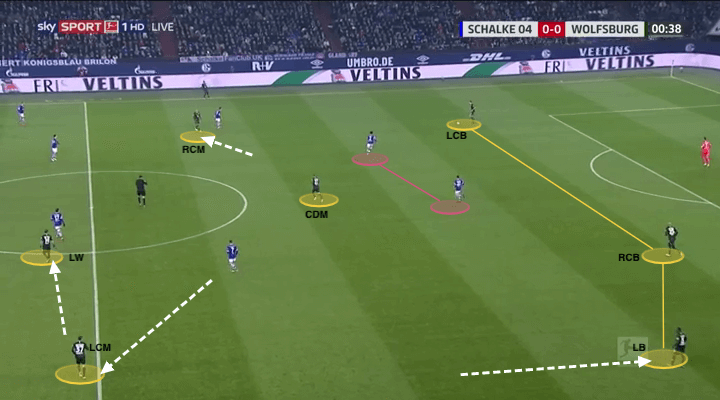
At Berlin, Niklas Stark will likely play a key role again under Labbadia.
In terms of contribution to the build-up play, he is Berlin’s most proficient centre-back.
With Karim Rekik, Jordan Torunarigha, and Dedrick Boyata the centre-back position is generally one where Hertha has some talent at hand despite recent problems.
The coach has the agony of choice, as the differences in quality are relatively small.
What was always impressive with Wolfsburg last season was their good occupation of spaces in higher zones and thereby offering passing options to progress the ball.
The 8s have an interesting and free-flowing role in this approach.
On the one hand, as already indicated in the example above, we can see them evading the centre and moving wide to occupy the flanks when the full-back drops and the winger moves inside.
On the other hand, they mostly occupy the half-spaces and push up higher almost acting as a number 10.
They are often the recipients in the half-spaces of progressive passes from the centre-backs or the dropping full-back/pivot.
Generally speaking, Wolfsburg always try to push up very high to get as many players as possible to a height with the opponent’s last line.
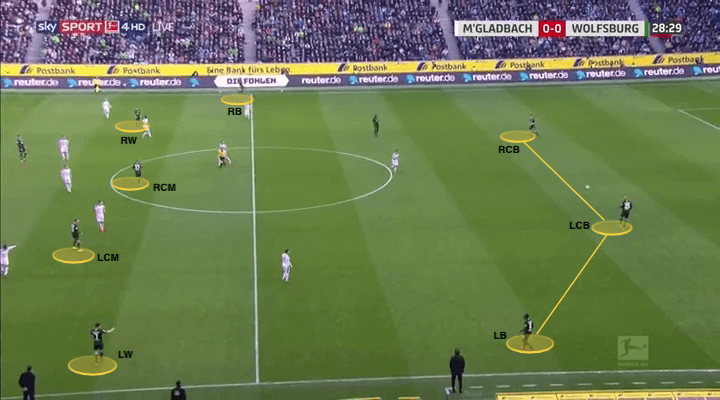
The role distribution between LCM and LW can vary and even the full-back can be found in the half-spaces to open up passing lanes to the flanks.
These switches are an essential part of Labbadia’s idea and one principle that occurs numerous times during matches.
The 4-3-3 structure allows triangles to be formed again and again between full-back, central-midfielder, and winger.
It does not really matter who occupies which position, it’s just important that the positions/zones are occupied at all.
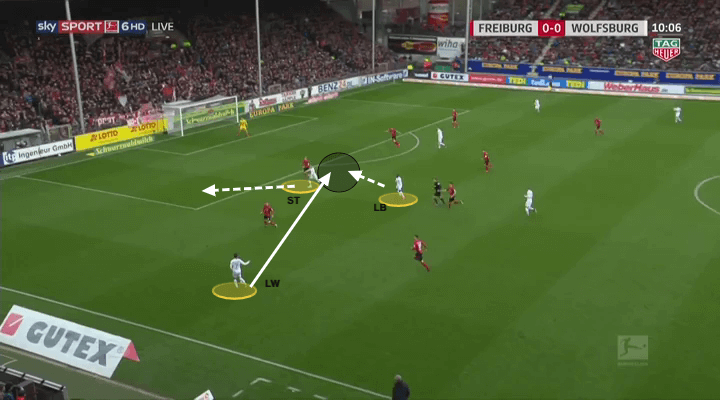
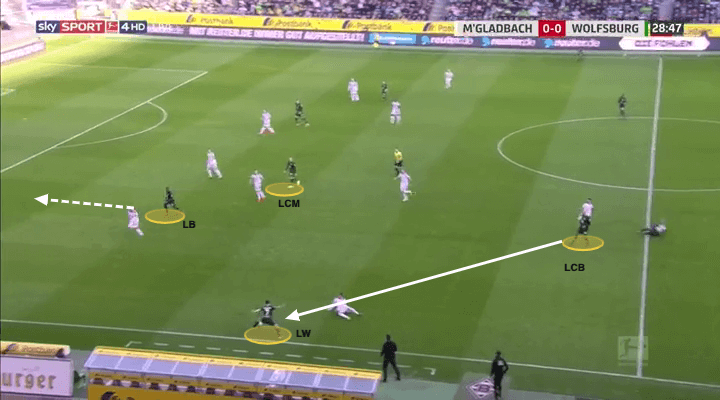
Looking at Hertha’s squad, Vladimír Darida and Marko Grujić currently seem to be the most suitable players for the role as central midfielders.
Another option might be Arne Maier, who we will talk about later.
However, this is a position where Hertha will certainly look for new additions in the summer not only since Grujić is going to return to Liverpool and Per Skjelbred, as well as Darida, are past their primes.
That said, the squad also consists of some promising youth players and especially Lazar Samardzic is someone from whom people in Berlin have a high opinion and expect a lot.
The role of the wingers is going to be another interesting case.
Labbadia constantly adjusts the roles of his players according to their strengths.
While Renato Steffen and Admir Mehmedi preferred to drive inside and occupy the half-spaces, Brekalo was also comfortable receiving the ball wide and dribble inside.
With Dilrosun and Lukebakio, the 54-year-old has two players of high individual quality and has to find a way to include them into his system.
Lukebakio can also be used in a central role and could fit into a 4-diamond-2.
Bruno Labbadia Approach against the ball
In Wolfsburg, Labbadia deployed a man-oriented way of pressing trying to prevent passes through the centre.
The wingers usually position themselves centrally and leave the opponent’s full-backs open.
With corresponding long balls on the wings, the 8s or the wings can push diagonally behind and press the opponent’s recipients together with their full-backs, who push higher out of the last line.
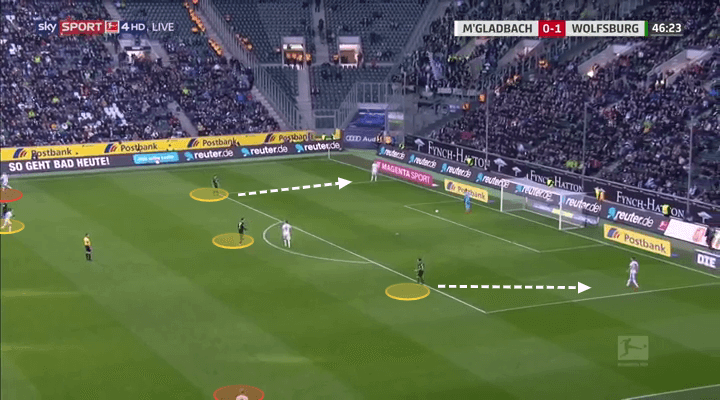
In these situations, the pivot plays an important role as he fills the open spaces that arise due to positioning adjustments.
His role in Labbadia’s tactics is an interesting one in general as he has a more zonal-oriented role covering the space behind the 8s.
He picks up different opponents depending on the situation, sometimes defending man-oriented and shifting outwards with the play.
This role requires an enormous effort, which Joshua Guilavogui was perfectly suited for.
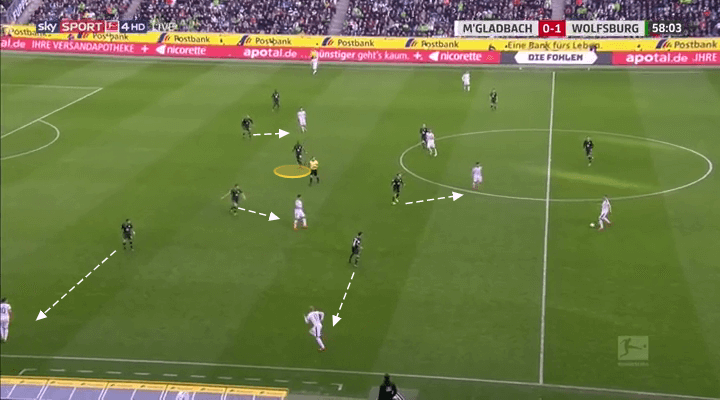
Who could deploy this position for Hertha? If it’s just about defensive tasks, Santiago Ascacibar seems to be the perfect player.
He is a small player but very aggressive and strong in defensive duels.
That said, he is not the type of player that excels with the ball and acts as a deep-lying playmaker in contrast to Arne Maier.
The 21-year-old is considered as Hertha’s biggest talent and one of the most promising in Germany.
Due to several injuries and problems with Klinsmann, he only amassed six appearances and asked for a transfer in the winter.
Now he seems to be fully fit again and might become an integral part of Labbadia’s midfield, especially considering their lack of individual quality in this part.
It’s also a question of how fast the players will understand Labbadia’s idea of football.
In Wolfsburg it took him until the next season to really implement it.
That said, we could see Labbadia opting for a more conservative approach in the beginning focusing more on aggressiveness and compactness against the ball while neglecting offensive principles until relegation is certainly avoided.
With Berlin, we will certainly see some situations where his team tries to press high and force the opponent to play long diagonal balls to the full-backs.
However, given Hertha’s recent defensive issues and the difficulties of practising clear processes together, we might see a more conservative approach in the beginning.
This might result in a higher focus on quick counterattacks.
With Lukebakio and Dilrosun, Hertha have two of the fastest player in the Bundesliga.
Does Labbadia fit Hertha’s philosophy?
Over the years, the club has gained a reputation for having one of the best youth academies and giving those players a chance to prove themselves in the Bundesliga.
One of the decisive factors for that was Dardai, who knew the club by heart and coached several youth teams before he was appointed as a head coach.
Covic had a similar career path and should have continued this way.
However, with the arrival of investor Lars Windhorst, a lot changed in Berlin.
The aim is not to develop homegrown talent but to become the “Big-City” club that plays in the Champions League and, one day, competes for the Meisterschale in the Bundesliga.
The winter transfer window has shown that they don’t hesitate to heavily invest in their squad to make that happen.
Furthermore, Lars Windhorst already indicated that he is willing to provide another significant amount of money to further improve the team.
Given the current circumstances, it might even possible to get better quality at a cheaper price due to the decreasing market.
However, looking at their recent signings, there’s no clear philosophy visible yet.
Most signings were in line with the ideas of Klinsmann, who pursued a rather conservative approach putting more emphasis on the defensive side.
To put that into context: Berlin appointed Covic who wanted to play offensively, switched to Klinsmann who wanted to play defensively and recently appointed Labbadia who wants to play offensively again.
All had different ideas of football.
On paper, the appointment of Labbadia makes sense for Berlin.
The 54-year-old has a proven track record of being able to take over teams in difficult situations and achieve short-term goals while playing offensive football.
In fact, at all clubs, he had success in some ways.
He is able to adapt according to the strengths of his players to get the better out of them.
At Berlin, his task is similar to Wolfsburg: finish the season properly and build a winning team with clear structures and a clear identity afterwards.
Labbadia himself is optimistic about his mission and explained that he is convinced of the quality of his players, who, in total, account for the eighth-highest market value in the Bundesliga.
Especially in the attack, he has some promising players at hand that he can build around, namely Lukebakio, Cunha, Piatek and Dilrosun.
With all the praise, one should not ignore the fact that his team in Wolfsburg significantly overperformed on the offensive end last season.
They scored twelve goals more than their Expected Goals-value, so one day a regression to the mean would have been inevitable.
In addition, Labbadia never had to manage a real crisis at Wolfsburg and injuries were no concern throughout the whole season.
What I try to point out is that one should absolutely acknowledge what he has achieved at Wolfsburg but some doubts whether he can be successful in Berlin in the long-term remain.
Conclusion
As this analysis has shown, on paper, the hiring of Bruno Labbadia appears to be a good solution for Hertha BSC Berlin.
While it can be doubted that he’s the one coach that makes Hertha the “Big-City Club”, he is definitely a coach that can bring the club closer to this goal.
He has a good track record of taking over teams in difficult situations and constantly improving them, which is exactly what Berlin currently need.
Hertha’s way moving forward can only read as follows: Avoid relegation, spend big on the transfer market, and eventually establish the club in Europe.





Comments